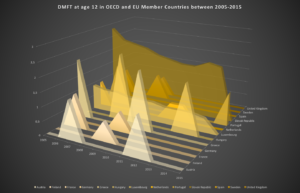Burden of dental caries
Dental caries is one of the most important global oral health burdens. The distribution and severity of dental caries vary in different countries. Dental caries experience in children is still relatively high [1].
Although there have been significant achievements in dental caries prevention and management in the European Union (EU), there is still a lot to be done. Evidences are developed, thus guidelines are provided for denta
l and healthcare professionals on caries prevention. There are also professional protocols available on how to use and promote fluoride, and sealants to prevent dental decay. Research has shown the correlation between caries experience and oral health behavior [2].
We can see now the evidence, and evidence based guidelines, protocols and recommendations. Many countries also have guidelines for caries risk assessment and caries management. But all these available protocols have to be turned into practice, and with monitoring, we need to measure the outcomes through different indicators to check their fulfilment and effectiveness.
So the translation of research into policy and practice should be a priority [3].

The DMFT (D-decayed, M-missing, F-filled, T-tooth) index is an important method in the oral epidemiology to assess dental caries prevalence.
Where the value is 0, it means there was no data available for that year.
The peaks indicate the DMFT value for the actual year.
It is visible that there is a high variety among these countries, both in the value of DMFT and the monitoring of dental caries.
The data collection protocol is different between the studied countries.
Some of the states collect data every year, while others only do it once every 10 years.

The graph shows the 10-years average DMFT of the OECD and European Union member countries [4].
Even the 10-years’ average shows big variety among the states.
Reference
[1] Bulletin of the World Health Organization 2005;83:661-669. Theme Papers. The global burden of oral diseases and risks to oral health, Poul Erik Petersen et al.
[2] A. Zaborskis et al.: Caries experience and oral health behaviour among 11 – 13-year-olds: An ecological study of data from 27 European countries, Israel, Canada and USA Article in Community dental health · June 2010 DOI: 10.1922/CDH_2383Narbutaite07[3] Pitts N, Amaechi B, Niederman R, Acevedo AM, Vianna R, Ganss C, Ismail A, Honkala E. 2011. Global oral health inequalities: Dental Caries Task Group–research agenda. Adv Dent Res. 23(2):211–220.
[4] stats.oecd.org